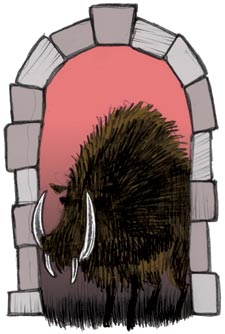What other cities, aside from the London of Neverwhere, might have something unusual just below the sidewalks?
Beijing: Dixia Cheng
In 1968 Chinese leader Mao Zedong ordered his people to dig tunnels in preparation for possible attack from the USSR. More than 300,000 local citizens, including many children, took part in digging the tunnels by hand, creating an underground city complete with a hospital, movie theater and arsenal. Many of the tunnels have fallen into disrepair, and no official entrances remain, although it is rumored that many private residences have trap doors that lead to the underground city.
Buenos Aires: Manzanas de las Luces
Beneath the streets of Buenos Aires several sections of underground tunnels connect the Manzanas de las Luces, or Blocks of Enlightenment. The Jesuits built the tunnels to connect their churches to one another, and they were named for the intellectual “light” that the churches brought to the city. In 1955 President Juan Peron used the tunnels to flee a military coup and escape from the country. Much of the tunnel system remains unexplored, although some sections are open for tours and cultural events.
Odessa: Museum of Partisan Glory
When the founders of Odessa ran out of limestone to build the city, they began digging out the rock beneath their feet. The resulting multilevel tunnels form a warren more than 550 miles long, only parts of which have ever been explored. The Museum of Partisan Glory contains a small stretch of tunnels that were used by the Ukrainian resistance during World War II against the Germans, complete with shooting gallery and stone “beds.” The rest of the tunnels have been home to smugglers, drug dealers and adventurous tourists, some of whom got lost in the underground maze never to be seen again.
Paris: Les Catacombes de Paris
By the end of the 18th century the cemeteries of Paris had reached capacity and were beginning to pose a health hazard. In 1785 a system of old quarries was chosen to house the remains of the Parisian dead. Bodies were moved nightly in a ceremonial procession made of priests singing the burial service while pushing carts full of bones from the cemetery to the catacombs. Once there, the bones were arranged in a “romantico-macabre” pattern with bones stacked to form pleasing designs within the crypt. The catacombs have always been popular with tourists; and even Napoleon visited the site.
Seattle: Pioneer Square
After the fire of 1889 destroyed much of Seattle, city leaders used the need to rebuild as an opportunity to raise street level above the marshy ground. Covered over with retaining walls and sidewalks, many of the downtown storefronts built on the original street level remained underground, untouched, until 1954 when a local historian discovered them and lobbied to have the area added to the National Register of Historic Places.
Sources
- "Beijing Underground City." The Official Website of the Beijing 2008 Olympic Games. 2008.
- "Catacomb Museum – Museum of Partisan Glory." Show Caves of the World.
- "Les Catacombes." Catacombs of Paris.
- Jiang, Steven. "Beijing Journal: An Underground 'Parallel Universe.'" CNN.com. February 1, 2008.
- "A Little History." Bill Speidel’s Underground Tour.
- “Partisan Glory Museum in Nerubayskoye Village: The Lost World of Catacombs”
- "Review of Manzanas de las Luces." Frommer's.com.
- Smith, Craig. "Beijing Journal; Mao’s Buried Past: A Strange, Subterranean City." New York Times, November 26, 2001, p. A.4.
Content last updated: April 30, 2011


